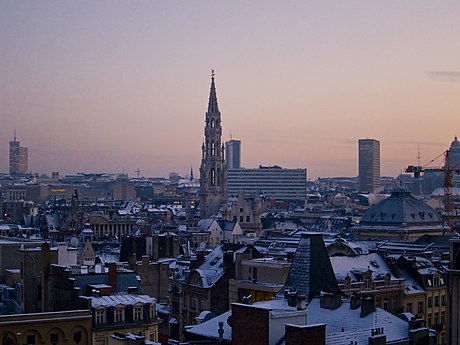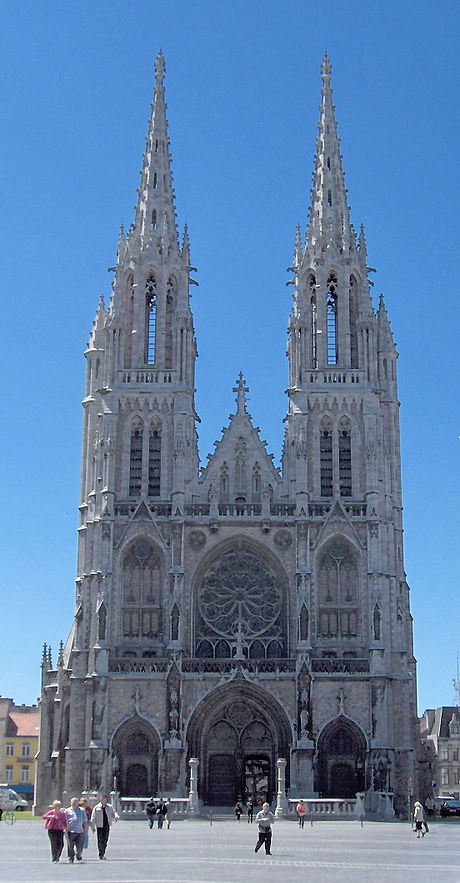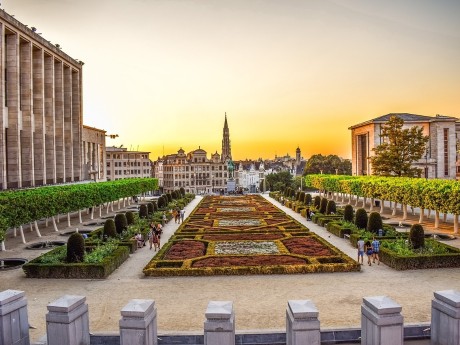Belgium: Brussels and Ostend
Embark on a delightful Belgian expedition, immersing yourself in the cultural tapestry of Brussels and Ostend. Begin in Brussels, the capital, where historic grandeur meets modern vibrancy. Explore the iconic Grand Place, indulge in exquisite chocolates and waffles or marvel at Atomium's futuristic allure. Next, venture to Ostend, a coastal haven blending North Sea tranquility with cultural richness.
Read more
Embark on a delightful Belgian expedition, immersing yourself in the cultural tapestry of Brussels and Ostend. Begin in Brussels, the capital, where historic grandeur meets modern vibrancy. Explore the iconic Grand Place, indulge in exquisite chocolates and waffles or marvel at Atomium's futuristic allure. Next, venture to Ostend, a coastal haven blending North Sea tranquility with cultural richness. Whether relaxing on the pristine beaches, taking in panoramic views from Fort Napoleon, exploring the maritime heritage at the Mercator Museum or immersing yourself in the vibrant art scene at the Mu.ZEE Museum, Ostend adds a maritime touch to your journey. This expedition promises an exquisite fusion of history, art, and culinary delights, ensuring an unforgettable sojourn through the heart of Europe. Waterviews strives to offer accommodation options within walking distance of water and/or in an area of touristic interest. Our prices include taxes (but excludes local tourist taxes). Customize your trip to your personal preferences with optional activities (hit the “Add Activities’’) or change hotels, etc. Contact us for customization at no extra cost at: Service@waterviewstravel.com
Destinations
- Brussels
- Ostend
Itinerary
Brussels

Brussels (French: Bruxelles, Dutch: Brussel) is the capital of Belgium and one of the three administrative regions within the country, together with Flanders and Wallonia. Apart from its role within its country, it is also an internationally important city, hosting numerous international institutions, and in particular the core institutions of the European Union. Due to that, it is sometimes referred to informally as the capital of the EU, and even used as a metonym for the EU institutions.
Brussels blends the heritage of a medieval Flemish town with the grandiose projects initiated after it became the capital of what was then a French-speaking country, as well as some impressive modern architecture erected in a large part to house the international institutions. Brussels is now bilingual, hosting and officially recognizing the Dutch- and French-speaking communities of Belgium, and has become increasingly international with the influx of people of various origin who came there to work, many of them for the European Union. This all makes Brussels a rather unique blend, sprinkled with a number of Belgian peculiarities, and for the inquisitive tourist a large treasure chest to discover.
Read more
Brussels (French: Bruxelles, Dutch: Brussel) is the capital of Belgium and one of the three administrative regions within the country, together with Flanders and Wallonia. Apart from its role within its country, it is also an internationally important city, hosting numerous international institutions, and in particular the core institutions of the European Union. Due to that, it is sometimes referred to informally as the capital of the EU, and even used as a metonym for the EU institutions.
Brussels blends the heritage of a medieval Flemish town with the grandiose projects initiated after it became the capital of what was then a French-speaking country, as well as some impressive modern architecture erected in a large part to house the international institutions. Brussels is now bilingual, hosting and officially recognizing the Dutch- and French-speaking communities of Belgium, and has become increasingly international with the influx of people of various origin who came there to work, many of them for the European Union. This all makes Brussels a rather unique blend, sprinkled with a number of Belgian peculiarities, and for the inquisitive tourist a large treasure chest to discover.
Additional Information
When Brussels became the capital city of a new country in the 19th century, large parts of the old town were destroyed to make way for brand new ministries, palaces, schools, army barracks and office blocks constructed between 1880 and 1980. The medieval city walls that once defended and surrounded the city were demolished. Only a small historic centre (one square and four adjacent streets) was preserved. The historic Flemish town centres are better preserved in cities like Antwerp, Bruges, Ghent, Leuven, and Mechelen. This thoughtless treatment of historic buildings has earned past city planners near-universal scorn and even given rise to the term "Brusselization" for cities that similarly tear down old buildings, replacing them with faceless concrete monstrosities.
Language
Language in Brussels can be a confusing matter to visitors. The common language is French, with around 90% of the population in Brussels speaking it passably to fluently. You can easily get by with English, especially in the tourist areas. Dutch is also an official language: within Brussels, the population that speaks Dutch passably to fluently is limited to around 20%, though Dutch-speakers make up the majority of Belgium as a whole. Because Brussels is the country's capital, when it comes to official matters, French and Dutch have equal status in Brussels, with sometimes complicated rules to ensure a balance between the two. Streets, railway stations, bus stops and other places have names in the two languages. The two names don’t always sound or look similar. For example, the Brussels-South railway station is Bruxelles-Midi in French and Brussel-Zuid in Dutch. Watch out when making assumptions based on English: a common mistake is to think Bruxelles-Midi refers to the Brussels-Central railway station, due to midi seeming similar to middle. Areas outside of Brussels have only one official language, but may still have distinct names in the other language. For example, you may get a train ticket that lists Anvers (in French) as the destination, but the signs in the station there will only say Antwerpen (in Dutch). In Brussels, large segments of the population have neither French nor Dutch as their mother tongue, and many other languages can be heard on the street, with Arabic being particularly common.
Historically Dutch-speaking, Brussels became more and more French-speaking during the 19th and 20th centuries. Today, most inhabitants speak French in daily life. Some numbers say that more than half of the inhabitants of Brussels do not speak French at home. The Brussels dialect, a Brabantian dialect of Dutch, can be heard, especially in the outer districts of Brussels Capital Region. The French spoken is standard French. Dutch speakers speak standard Dutch but many also speak a dialect when talking to people from their region.
English has become a common spoken language because of the international institutions based in Brussels, such as the European Commission, the European Parliament and NATO. It is still relatively rare to find written tourist or general information in English, although the situation is changing. One can expect public announcements in train stations to at least be said in French and Dutch, while larger train stations (such as Zuidstation/Gare du Midi) typically include English and German. English is also used on metros, trams and buses, announced last for information such as line transfers and terminal stops. Do not hesitate to ask someone if you do not understand what has been said.
Considering the city's location and that it markets itself as the capital of Europe, spoken English is less prevalent in Belgium than in its Dutch neighbour. However, even if it is not as widely spoken as one may expect, it is nonetheless widely understood. As is often the case elsewhere, success in finding someone who speaks English depends on several factors such as age (14-35 year-olds are most likely to speak English), education and previous experience abroad.
German is also an official language in Belgium spoken as a mother tongue by about 70,000 people in the east of the country bordering Germany, but the only German you're likely to hear in Brussels would be overheard on the streets around the European institutions or by German tourists, even if there is a large German population residing there.
Other languages that are increasingly heard in Brussels include Arabic (at least 25% of Brussels' population is of Arab descent, chiefly from Morocco), Spanish, Italian, Portuguese, Polish, and Russian.
Climate
Brussels' weather deservedly has a poor reputation. Rainfall is frequent and fairly evenly distributed over the seasons, although spring (March - May) and autumn (September - November) tend to see the most rain. With an annual rainfall of 820 mm spread over approximately 200 rainy days per year, the city gets to endure more rain than neighboring capitals Paris or London, and that regular rainfall makes the climate damp. Under high humidity, the rare warm days tend to feel uncomfortably hot, and the many cold days feel colder than elsewhere.
The best season to visit Brussels would be from late spring to early autumn, generally half May to half September would yield the highest chance of sunny weather. However, even the summer months are not immune from rain and can be very unpredictable: you can be lucky and enjoy a few dry days, but there is an equal chance you'll be confronted with rain for days on end. Bring ample waterproof clothes, preferably with long sleeves. Wet clothes don't dry easily in Brussels' humid climate and infrequent sunshine, so if you get wet, you'll probably have to sustain damp clothes for the rest of the day. An umbrella is an essential accessory in every season! Daily temperature variations are always below 10°C, so you typically don't have to worry about changing into something warmer/cooler over the course of the day. In summer, the average temperature is about 22°C, but don't take it as clothing advice: one week you might experience autumn weather and 15°C, and the next you might (briefly) enjoy 30°C or more! After October, temperatures drop off quite quickly, and sunny days become rare (In December 2017, Brussels shattered the European record for least amount of sunshine in a month).
However, snowfall is uncommon in winter, with 3 - 5 snowy days per year at best, although there have been years with no snowfall at all. Snow usually falls overnight, and not more than a few cm at a time. It tends to melt within a few hours, gradually turning from a idyllic landscape into a brown watery slush that is unpleasant to walk through. When visiting Brussels in winter, bring suitable footwear. Gloves are also recommended, particularly on a bike or while holding a map.
Preparing your visit
Brussels has as many indoor as outdoor activities to offer, so even if it turns out to rain every day of your visit, you'll find more than enough to do to make the visit worthwhile. The Buienradar (literally Shower Radar) shows the real time location of rain clouds and calculates predictions of their movements. The radar can tell when it will start to rain at your position with a 10 minute accuracy, and is a great tool for planning out your day.
Although Brussels is best explored by foot or by bike, the public transport network is the best option when it's raining. Museums and other attractions are rarely more than 10 minutes walking away from a metro station, so a map of the metro network in combination with the Buienradar can keep you dry through adequate planning. If you're caught by surprise, metro stations are excellent places to seek shelter from the rain, and the larger stations have facilities where you can purchase a hot beverage while waiting (, , , and so on). Chains like Starbucks, Panos, McDonalds and the likes don't care if you occupy a table without making a purchase, so these are good options to sit out longer showers.
Boroughs
Brussels is split into 19 communes or gemeenten (municipalities/boroughs): **Bruxelles/Brussel ** - Brussels offers many charming and beautiful attractions, with deeply ornate buildings on the Grand Place/Grote Markt, and a fish-and-crustacean overdose of St. Catherine's Square (Place St-Catherine/Sint-Katelijneplein). Stroll along, (and stop in for a drink) at one of the many bars on Place St-Géry/Sint-Goriksplein, or max out your credit card on the trendy Rue Antoine Dansaert/Antoine Dansaertstraat. Marolles/Marollen - A neighbourhood of Brussels close to the city's heart, one of the few places where the Brussels dialect of Dutch (Flemish) could still be heard. The area is best known for the flea market held daily on the Place du Jeu de Balle/Vossenplein and for a plethora of shops selling everything from old radios and bent wipers to fine china and expensive Art Nouveau trinkets. Visit on Saturdays or Sundays. **Brussels/Ixelles-Elsene ** - A vibrant part of town with a high concentration of restaurants, bars and other services to satisfy the good-looking or the heavy-spending. Some wandering around will reveal small bookshops, affordable ethnic restaurants or independent record shops tucked away in side streets. The Matongé district just off Chaussée d'Ixelles/Elsenesteenweg is the city's main African neighbourhood. It is a large district in the South of Brussels spreading from newly gentrified immigrant neighbourhoods off the Chaussée d'Ixelles/Elsenesteenweg near the town centre to leafy suburbs close to the Bois de la Cambre/Ter Kamerenbos. The district is split in two by Avenue Louise/Louizalaan, which is part of the Bruxelles/Brussel district of the city. Molenbeek/Molenbeek - Commonly known as Molenbeek-St-Jean or Sint-Jans-Molenbeek. The population has been described as "mainly Muslim" in the media; however, actual figures range between 25% and 40%, depending on the catchment area. As of 2016, there is one main minority group in Molenbeek, Belgian Moroccans. Saint-Gilles/Sint-Gillis - The city's bohemian epicentre with thriving French, Portuguese, Spanish, Maghrebi and Polish communities. The area around the Parvis de St-Gilles/St-Gillisvoorplein is the arty part, with the area around the Chatelain/Kastelein and the Church of the Holy Trinity being decidedly more yuppified. Like Schaerbeek, Saint-Gilles boasts several Art Nouveau and Haussmann-style buildings. St-Josse/Sint-Joost - The smallest and poorest commune not only of Brussels, but of all Belgium, this commune might not always be too pleasing on the eye but does have a few small, welcoming streets. The mid-part of the Chaussée de Louvain/Leuvensesteenweg is also home to a relatively small Indo-Pakistani community, so this is the place to head to for a tikka masala. The Turkish community which was the largest community only a few years ago has declined rapidly, as they moved to relatively wealthier communes by St-Josse/Sint-Joost standards. Uccle/Ukkel - Brussels' poshest commune. Green, bourgeois and starched like all posh communes should be. Uccle has retained many of its charming medieval cul-de-sacs, tiny squares and small townhouses as has nearby Watermael-Boitsfort/Watermaal-Bosvoorde. Woluwé-Saint-Pierre/Sint-Pieters-Woluwe and Woluwé-Saint-Lambert/Sint-Lambrechts-Woluwe are two communes at the eastern end of the city. Mainly residential, with a mixture of housing blocks, quaint neighbourhoods and green areas this place is well-loved by Eurocrats and other professional types. The enormous Wolubilis cultural complex is well worth a visit.
Tourist offices
© Sourced from Wikivoyage
Ostend

Ostend (Dutch: Oostende) is a seaside city of 70,000 inhabitants in West Flanders in Belgium. Its North Sea beaches have drawn in tourists since the 19th century when it was a fashionable outing for royalty and aristocracy. It has since become more democratic and is now densely built up with tall 20th-century blocks of holiday apartments and hotels. Its waterfront promenade features every cliche of a European seaside holiday, including a large musical theatre and casino. Besides being a holiday destination, Ostend is also a sizeable port for cargo traffic, particularly across the English Channel. Passenger lines towards the UK have ceased.
Read more
Ostend (Dutch: Oostende) is a seaside city of 70,000 inhabitants in West Flanders in Belgium. Its North Sea beaches have drawn in tourists since the 19th century when it was a fashionable outing for royalty and aristocracy. It has since become more democratic and is now densely built up with tall 20th-century blocks of holiday apartments and hotels. Its waterfront promenade features every cliche of a European seaside holiday, including a large musical theatre and casino. Besides being a holiday destination, Ostend is also a sizeable port for cargo traffic, particularly across the English Channel. Passenger lines towards the UK have ceased.
Additional Information
Ostend used to be a small fishing village on the easternmost edge of an island on the shore of the coast. The original town centre is 200 m away in the sea compared to the present day seashore. After the town was flooded and destroyed several times by severe storms, it was moved onshore to its current location. The mudflat between the island and the coastline gradually sanded and the island became a part of the main land. Ostend prospered as a market town. In the 17th century the harbour of Ostend gained importance. Ostend received a lot of attention of Belgian kings Leopold I and Leopold II, since they liked to spend their holidays here. They built many important buildings in the city, such as the Hippodrome Wellington horse racing track and the Royal Galleries. Thanks to these investments Ostend started to be called "Queen of the Belgian sea-side resorts". In the 20th century Ostend hosted all of the sailing events for the 1920 Olympic Games for Antwerp.
Post-war hunger for investments destroyed much of Ostend's original charm with tall concrete apartment buildings. Some relics of the historical Ostend however managed to survive and can still be found.
Climate
Ostend has a maritime temperature climate which is heavily influenced by the winds from the North Sea. Due to these winds summers here are much cooler than in inland Europe. On the other hand night temperatures below the freezing point are not very common in winter.
© Sourced from Wikivoyage





